Laser surgery for varicose veins
In addition to standard varicose vein removal operations, there is modern technology for laser surgery.
Preparation for surgery
By the time of surgery, the patient is fully examined, a conversation was held with him about the necessary preparation and hygiene before surgery, all issues related to surgery and postoperative period were clarified.
No additional training is required on the day of surgery. For convenience, it is recommended to come to the clinic in loose clothing and always in comfortable shoes without heels. Make the last meal in at least 4 hours.
The patient is admitted to the clinic, staged training is carried out with him, painkillers and sedatives are administered, and allergy tests are performed. Then ultrasound with mapping of the affected veins is performed. This means that during the ultrasound examination the patient's leg is drawn a "map" of the affected veins, the diameter, wall thickness, features of the venous system, places of special attention, etc. are specified. This directly affects the choice of laser mode.
Technology of operation
Stage one
Laser treatment takes place in a sterile operating room. The intervention site must be treated with antiseptics. During the operation, under local anaesthesia, a vein is punctured below the knee, and a laser light guide is inserted into it. The sensation of manipulation does not differ from the usual intravenous injection. The light guide is conducted through a vein in the groin area and is installed in a specific place where the superficial vein flows deep. Tuminescent anaesthesia is performed, an anaesthetic solution is injected along the entire vein, and a kind of "water cushion" is created around the vein. This prevents pain and protects the tissues surrounding the vein from burns, as well as squeezing all the blood out of the vein to ensure the most effective effect of laser radiation. This is done by a series of injections with a special pump and is probably the most unpleasant stage of the operation. After that laser coagulation of veins is carried out directly, control of this process constantly proceeds on ultrasonography, the light guide "passes" on a vein and thus completely "brews" it. At this stage, the patient may experience a slight burning or tingling sensation, a feeling of warmth along the treated vein. All these manipulations can be observed by the patient together with doctors on the screen of the ultrasound machine, which gives the patient confidence and a sense of security, eliminates the fear of surgery. The duration of this stage lasts on average up to 10 minutes.
The second stage
In the second stage, all affected varicose veins that have not been "welded" by the laser are removed with the help of special tools - phlebological hooks. The procedure is performed, after local anaesthesia through skin punctures (2-3 mm) and does not cause pain. At the end of this stage, the skin punctures are sealed with a special plaster, a multilayer bandage is applied, consisting of an aseptic bandage, elastic bandage and hospital stocking. Immediately after the operation, the patient goes to the ward on his own and walks for at least 40-60 minutes. This ensures the redistribution of blood through healthy veins and stimulates blood flow through the deep veins.
Postoperative period
After the operation, the patient is recommended an active motor regime for the next 3 weeks, so there is no bed rest. The patient is completely active and does not require any outside help or care. Only two dressings will be needed after the operation. The first is performed the day after the operation and consists of changing the patches, healing the wounds and replacing the tight postoperative bandage with a regular elastic bandage. The second is held for 6-7 days. At the same time, patches and sutures are removed from postoperative wounds, if any, compression stockings are put on, training on their dressing and care is provided, and recommendations for further behaviour of the patient are given.
In many clinics, compression stockings are worn immediately after surgery, but we divide compression therapy after surgery into stages. The fact is that in 1-2 days from the wounds are actively separated fluid, consisting of injected into the leg analgesic solution and blood secretions. The surgeon's work is performed directly on the vessels containing blood, so when they are removed, it is quite natural to bleed. Such discharges will come into contact with the compression stocking and damage it. Also, the process of putting on such stockings is not an easy task, it requires a certain skill. When putting on and taking off, the patches will definitely come off. In this case, firstly, you will have to come for additional dressing, and secondly, the wound will heal incorrectly and not beautifully enough. Therefore, we prefer this method: first a week to bandage the leg with an elastic bandage and the first 2-3 days for a whole day, and then the bandage can be removed at night.
In a week, after the removal of plasters and seams, the compression product is put on. The mandatory period of wearing compression stockings is a month after surgery, then - only under heavy loads.
Discomfort and limitations during rehabilitation
As well as after any operation, after surgical intervention using the laser certain easy painful sensations of burning, tingling, heaviness in a leg can be noted. This usually happens only on the first day and is associated with the obligatory tight bandage. The most common complaint of patients is a feeling of tightness and discomfort from the bandage. It is absolutely tolerable and does not even require the appointment of painkillers. Because the operated limb does not bother, either immediately after the operation, or in the future, such an active and painless condition immediately returns the patient to a normal lifestyle.
All restrictions after such an operation apply only to the prohibition of hygienic procedures (you cannot wash your feet for seven or eight days: how to adapt to taking a shower during this period, your doctor will tell), sports, baths or saunas, running, jumping and lifting heavy more than 5 kg, it is also not recommended to drive the car for the first 2-3 days. We can let patients go to work the next day. Sometimes, after long and extensive surgeries, we recommend staying at home during the day and monitoring your condition and sensations in the leg and then go to work.
Complications during laser surgery
After any operation, bruising is possible. They are never common and malignant, more pronounced in 3-4 days and pass on their own within 2-3 weeks, and only bother aesthetically. In isolated cases, there may be slight swelling in the lower leg near the foot, most often it occurs in the advanced stages of the disease or massive lesions of the veins and is associated with natural processes of redistribution of blood flow in the veins. In isolated cases, 5-6 days after surgery, there may be a feeling of a foreign body or sipping in the thigh, especially when it is removed. It is absolutely safe and is connected with the natural processes occurring in the "burnt" vein. These feelings go away on their own within 10-14 days. Pain is quite rare, and if it occurs, it is very weak and short-lived. Sometimes there is numbness of the skin at the bottom of the foot near the foot. Such feelings pass quite quickly, do not reduce efficiency and do not bother too much.
Such serious complications as thrombophlebitis and thrombosis are almost non-existent in our practice. The development of such complications was characteristic of treatment with previous generation equipment and completely different laser light guides. In modern Phlebology, laser devices with a wavelength of 1470 nm and two-ring optical fibers are recognized as equipment with proven maximum efficiency. The use of these innovative techniques means allows achieving the maximum possible, stable and long-lasting result absolutely reliably, painlessly and safely. Minimal tissue trauma and the absence of incisions during this operation reduces to almost zero the likelihood of infectious complications.
Postoperative wounds heal very quickly, traces of punctures or mini-accesses become invisible in about 4-6 months, although this period depends solely on the individual structure of the skin.
Monitoring the result of the operation
At 1, 3, 6 and 12 months after surgery, you must appear for a check-up. Ultrasound examinations are performed to obtain information about the process of transformation of coagulated veins, as well as the dynamics of the disease or the absence of its symptoms. Thus, the patient is under the active dynamic supervision of specialists, which guarantees the stability of the postoperative period and the timely detection of any changes.
Thus, modern surgery is convenient and safe for patients, allows you to cure the patient quickly, painlessly, with a high cosmetic result, without abandoning the usual lifestyle.
The article was prepared by a vascular surgeon of the highest category, phlebologist Volodymyr Gerasimov.
For information on treatment and appointment, call the contact center of MM "Dobrobut": +38 (067) 333-17-98 or +38 (067) 333-17-98.
Our services
Our advantages
Choose the nearest clinic
ISO certificates
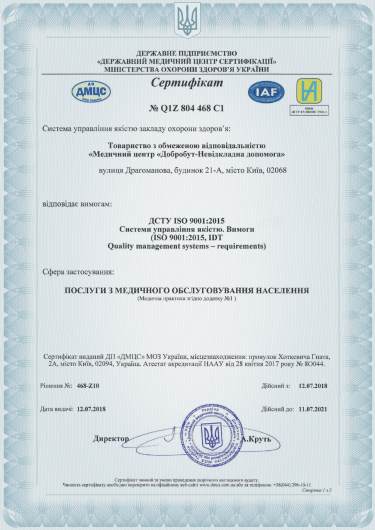
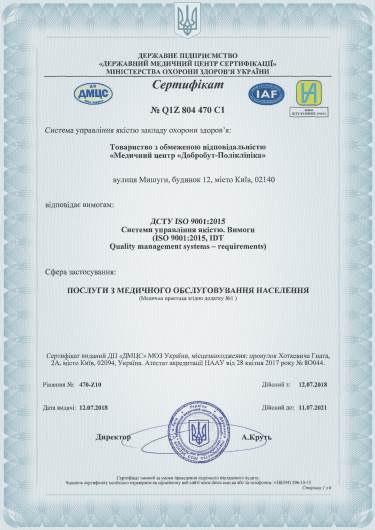
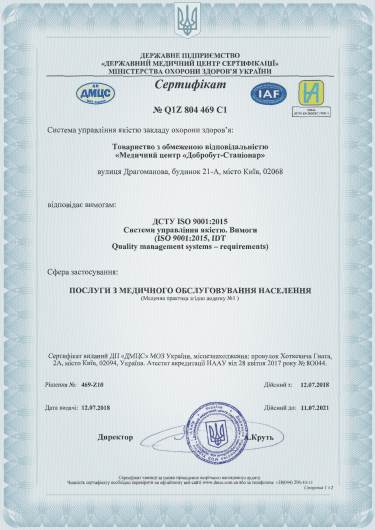
Accreditation certificates
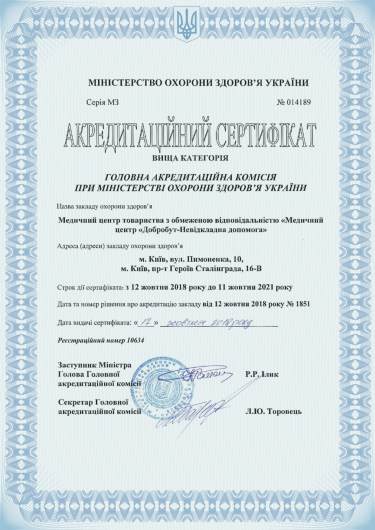
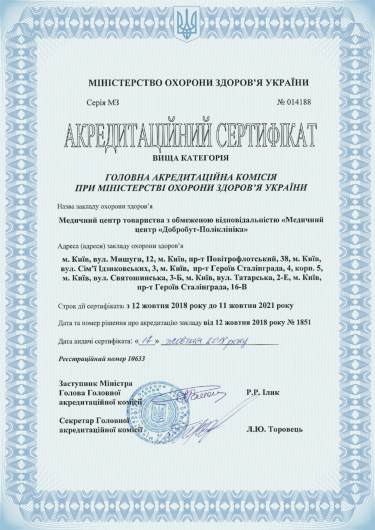

Licenses of medical practice
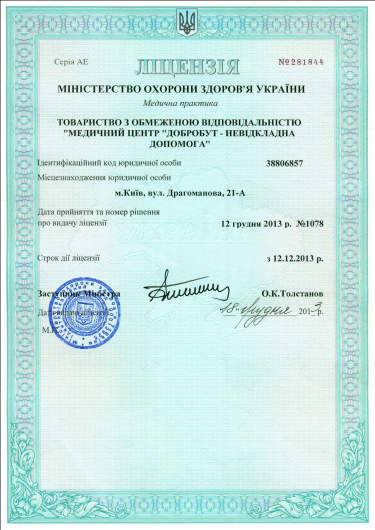
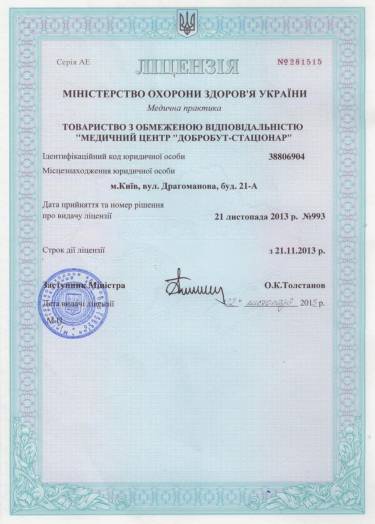

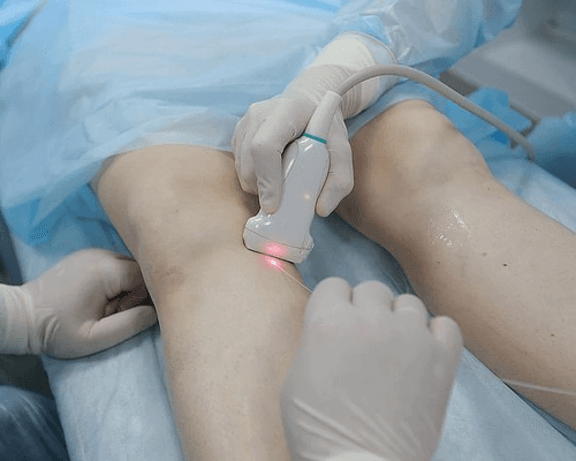


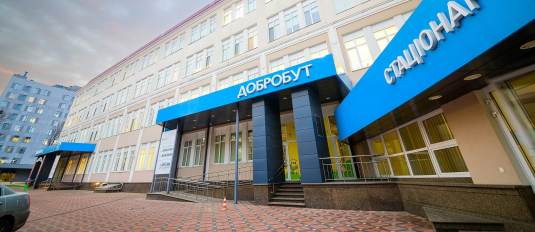
%402x.png)
%402x.png)
